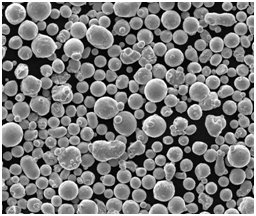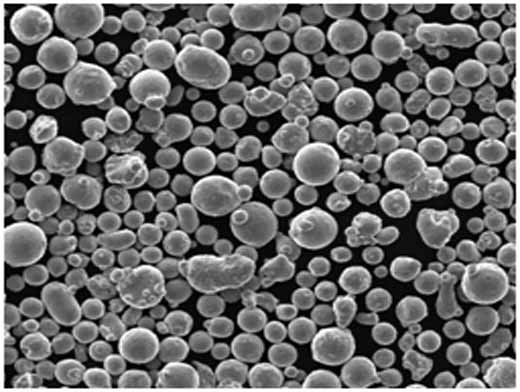Überblick über CuSnTi-Pulver
CuSnTi-Pulver ist ein einzigartiges Pulver aus einer Kupfer-Zinn-Titan-Legierung, das häufig in der modernen Fertigungsindustrie verwendet wird. Seine außergewöhnlichen Eigenschaften - wie Korrosionsbeständigkeit, Langlebigkeit und thermische Stabilität - machen es ideal für Branchen von der Luft- und Raumfahrt bis zur Elektronik. In diesem Artikel werden wir die spezifischen Eigenschaften, Anwendungen und wichtigsten Produktmodelle von CuSnTi-Pulver im Detail aufschlüsseln.
Ob Sie ein Käufer, ein Ingenieur oder einfach nur neugierig auf CuSnTi-Pulver sind, dieser Leitfaden enthält alles, was Sie brauchen.
Behandelte Hauptthemen
- Was ist CuSnTi-Pulver?
- Detaillierte Zusammensetzungen und Eigenschaften
- Branchenübergreifende Anwendungen
- Spezifikationen, Größen und Qualitäten
- Vor- und Nachteile der verschiedenen CuSnTi-Pulvermodelle
- FAQs und Expertenwissen

Zusammensetzung von CuSnTi-Pulver
CuSnTi-Pulver enthält in der Regel Kupfer (Cu), Zinn (Sn) und Titan (Ti) als primäre Elemente. Die genaue Zusammensetzung variiert je nach Modell und beeinflusst Eigenschaften wie Schmelzpunkt, Korrosionsbeständigkeit und Kompatibilität mit verschiedenen Herstellungsverfahren. Im Folgenden werden die Besonderheiten der Zusammensetzung aufgeschlüsselt, damit Sie verstehen, was die einzelnen Modelle voneinander unterscheidet.
| Pulver-Modell | Kupfer (%) | Zinn (%) | Titan (%) | Zusätzliche Elemente |
|---|---|---|---|---|
| Modell A | 75 | 20 | 5 | Keine |
| Modell B | 70 | 25 | 5 | Spuren von Eisen |
| Modell C | 68 | 30 | 2 | Bor für erhöhte Festigkeit |
| Modell D | 80 | 15 | 5 | Molybdän für Zähigkeit |
| Modell E | 65 | 25 | 10 | Nickel für zusätzliche Korrosionsbeständigkeit |
| Modell F | 60 | 30 | 10 | Zink für erhöhte Härte |
| Modell G | 72 | 18 | 10 | Keine |
| Modell H | 78 | 12 | 10 | Chrom für thermische Stabilität |
| Modell I | 62 | 28 | 10 | Phosphor für leichtes Gießen |
| Modell J | 64 | 26 | 10 | Aluminium zur Gewichtsreduzierung |
Eigenschaften von CuSnTi-Pulver
Die Eigenschaften von CuSnTi-Pulver hängen in hohem Maße von den Zusammensetzungsverhältnissen von Kupfer, Zinn und Titan ab, die jeweils einzigartige Eigenschaften aufweisen. Im Folgenden finden Sie eine Aufschlüsselung der wichtigsten Eigenschaften, die CuSnTi-Pulver zu einer beliebten Wahl für anspruchsvolle Anwendungen machen:
| Charakteristisch | Beschreibung |
|---|---|
| Hohe Korrosionsbeständigkeit | CuSnTi-Pulver ist rost- und korrosionsbeständig und eignet sich daher hervorragend für Teile, die Feuchtigkeit oder Chemikalien ausgesetzt sind. |
| Wärmeleitfähigkeit | Aufgrund seiner ausgezeichneten Wärmeleitfähigkeit eignet sich CuSnTi ideal für wärmeübertragende Anwendungen, von der Kühlung von Elektronik bis hin zur Hochtemperaturfertigung. |
| Stärke und Langlebigkeit | Die Zugabe von Titan erhöht die Zugfestigkeit und Haltbarkeit der Teile, so dass sie auch unter schwierigen Bedingungen eingesetzt werden können. |
| Verformbarkeit | Es ist mäßig verformbar, so dass es geformt oder gegossen werden kann, hat aber eine höhere Härte als reines Kupferpulver. |
| Verschleißfestigkeit | Die Struktur der Legierung trägt zur Verschleißfestigkeit bei und eignet sich daher für Bauteile, die Reibung ausgesetzt sind. |
| Leichte Komposition | Trotz seiner Festigkeit ist CuSnTi im Vergleich zu anderen Metallpulvern mit ähnlicher Haltbarkeit relativ leicht, was die Effizienz von Teilen für die Luft- und Raumfahrt verbessert. |
| Oxidationsbeständigkeit | Hochgradig oxidationsbeständig, behält seine strukturelle Integrität auch dann bei, wenn es über einen längeren Zeitraum Luft oder Wasser ausgesetzt ist. |
Anwendungen von CuSnTi-Pulver
CuSnTi-Pulver wird aufgrund seiner robusten Eigenschaften in verschiedenen Branchen eingesetzt. Hier ein Blick darauf, wo es üblicherweise verwendet wird und warum:
| Industrie | Anmeldung | Warum CuSnTi-Pulver ideal ist |
|---|---|---|
| Luft- und Raumfahrt | Triebwerkskomponenten, Strukturträger | Leicht und langlebig, widersteht hohen Temperaturen und Belastungen. |
| Automobilindustrie | Zahnräder, Kolben und Lager | Widerstandsfähig gegen Verschleiß, ideal für bewegliche Teile, die Reibung und Hitze ausgesetzt sind. |
| Elektronik | Kühlkörper, gedruckte Schaltungen | Die hohe Wärmeleitfähigkeit unterstützt das Wärmemanagement, das für die Stabilität und Langlebigkeit der Elektronik entscheidend ist. |
| Medizinische Geräte | Chirurgische Instrumente, implantierbare Komponenten | Biokompatibel und korrosionsbeständig, daher sicher für den Einsatz im menschlichen Körper. |
| Marine | Propellerblätter, Unterwasserarmaturen | Außergewöhnliche Korrosionsbeständigkeit, wichtig für Teile, die Salzwasser und Meeresumgebungen ausgesetzt sind. |
| Herstellung | Formeinsätze, Schneidwerkzeuge | Hohe Festigkeit und Verformungsbeständigkeit, ideal für Formen und Werkzeuge, die hohen Belastungen und Verschleiß ausgesetzt sind. |
| Bauwesen | Strukturelle Verstärkungen, Beschläge | Langlebig, korrosionsbeständig und kosteneffizient für die strukturelle Integrität. |
| Schmuck | Dekorative Komponenten, hochwertige Uhren | Einzigartige Farbgebung und Anlaufbeständigkeit, ideal für ästhetische und funktionelle Langlebigkeit. |
| 3D-Druck | Additive Fertigung aus Metall für Prototypen | Die feine Pulverkörnung ermöglicht eine präzise Schichtung und eignet sich perfekt für hochauflösende Prototypen und kundenspezifische Teile. |






Spezifikationen, Größen, Qualitäten und Normen für CuSnTi-Pulver
Die Wahl des richtigen CuSnTi-Pulvers hängt oft von Ihren Projektspezifikationen ab, die bestimmte Qualitäten, Partikelgrößen oder Konformitätsstandards erfordern können.
| Klasse | Partikelgrößenbereich (µm) | Einhaltung der Normen | Beschreibung |
|---|---|---|---|
| Note 100 | 10-20 | ASTM B213 | Geeignet für Anwendungen mit feinen Details wie 3D-Druck und Präzisionsguss. |
| Klasse 200 | 20-50 | ISO 3923-1 | Ideal für mittelgroße Details und hohe Festigkeitsanforderungen bei Automobilteilen. |
| Klasse 300 | 50-100 | ASTM B962 | Gröbere Körnung, geeignet für strukturelle Verstärkungen und Schwerlastanwendungen. |
| Klasse 400 | 10-45 | AMS 4990 | Für die Luft- und Raumfahrt geeignetes Pulver, das hohe Anforderungen an Haltbarkeit und Wärmebeständigkeit erfüllt. |
| Klasse 500 | 30-70 | JIS Z2505 | Vielseitige Sorte für den allgemeinen industriellen Einsatz, die ein gutes Gleichgewicht zwischen Festigkeit und Verformbarkeit bietet. |
| Klasse 600 | 70-150 | EN 13942 | Am besten geeignet für größere Strukturteile, die keine hohe Präzision erfordern, wie z. B. Formeinsätze und Werkzeugteile. |
| Klasse 700 | 15-35 | ASTM B329 | Entwickelt für Wärmesenken und Wärmemanagementteile aufgrund der hervorragenden Leitfähigkeit. |
Vergleich der Vor- und Nachteile von CuSnTi-Pulvermodellen
Die verschiedenen Modelle haben je nach Zusammensetzung und Verwendungszweck spezifische Vor- und Nachteile. Hier ist ein Vergleich:
| Pulver-Modell | Vorteile | Benachteiligungen |
|---|---|---|
| Modell A | Kostengünstig, gut für den allgemeinen Gebrauch | Geringere Korrosionsbeständigkeit im Vergleich zu anderen |
| Modell B | Ausgezeichnete Festigkeit und Verschleißfestigkeit | Geringfügig höhere Kosten aufgrund der zusätzlichen Elemente |
| Modell C | Hervorragend geeignet für das Wärmemanagement, ausgewogene Haltbarkeit | Weniger verformbar für komplizierte Designs |
| Modell D | Robust und langlebig, ideal für den Einsatz im Bauwesen | Schwerer als andere Puder |
| Modell E | Hohe Korrosionsbeständigkeit, geringes Gewicht | Höhere Kosten aufgrund des Nickelzusatzes |
| Modell F | Hohe Härte, gut für Maschinen geeignet | Geringere Wärmeleitfähigkeit |
| Modell G | Vielseitig, sowohl für die Automobilindustrie als auch für die Luft- und Raumfahrt geeignet | Weniger wirksam in Salzwasserumgebungen |

FAQs
| Frage | Antwort |
|---|---|
| Wofür wird CuSnTi-Pulver hauptsächlich verwendet? | CuSnTi-Pulver wird aufgrund seiner Festigkeit und Widerstandsfähigkeit häufig in der Luft- und Raumfahrt, in der Automobilindustrie, in der Elektronik und in medizinischen Geräten verwendet. |
| Wie wähle ich die richtige Qualität von CuSnTi-Pulver? | Berücksichtigen Sie die Anforderungen der Anwendung, z. B. Partikelgröße, Haltbarkeit und spezifische Industrienormen. |
| Ist CuSnTi-Pulver für den 3D-Druck geeignet? | Ja, vor allem in feinen Qualitäten; es bietet gute Präzision und Haltbarkeit für die additive Fertigung. |
| Wie ist CuSnTi-Pulver im Vergleich zu reinem Kupfer? | Es bietet eine bessere Korrosionsbeständigkeit, Haltbarkeit und thermische Stabilität, ist jedoch etwas weniger leitfähig. |
| Wie hoch sind die Kosten für CuSnTi-Pulver? | Die Preise variieren je nach Zusammensetzung und Qualität, in der Regel zwischen 50 und 150 Dollar pro |

